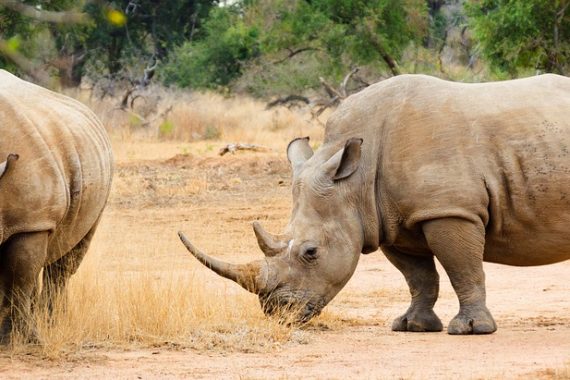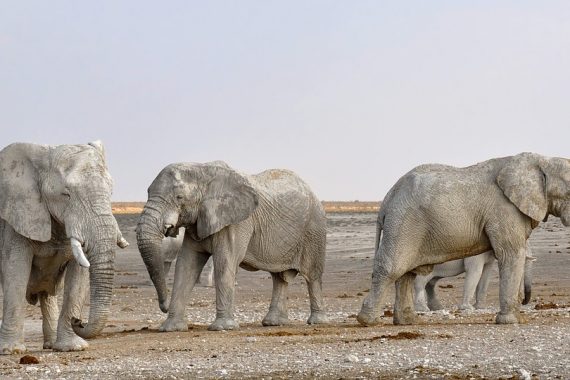Paradise Tree Snake (Chrysopelesa paradisi)
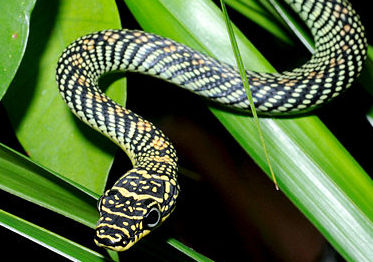
The beautifully patterned Paradise Tree Snake (image from https://www.ecologyasia.com/verts/snakes/paradise_tree-snake.html)
Vividly patterned with a slender body, the Paradise Tree Snake is a species of ‘flying snake’ found throughout Southeastern Asia. This species is part of the Chrysopelea genus, which is a part of the Colubridae family of snakes, the largest family with 249 genera, found on every continent except for Antarctica. Like other members of its genus, the Paradise tree snake is mildly venomous, although it is generally considered dangerous only to its small prey, which generally consist of small rodents, reptiles and amphibians. They have tiny, fixed rear fangs, which is the reason why they are relatively harmless to humans. However, sometimes they can be unfortunate victims themselves; check out this amazing image below of an unlucky paradise tree snake falling prey to the web of a Giant Golden Orb Weaver spider!
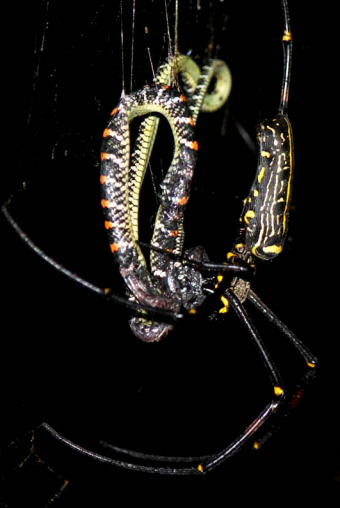
An unlucky paradise tree snake that landed in the web of a Giant Golden Orb Weaver spider and became its lunch! (Image from Marvin J.R Sarmiento et al)
Science fiction or fact: a flying snake?
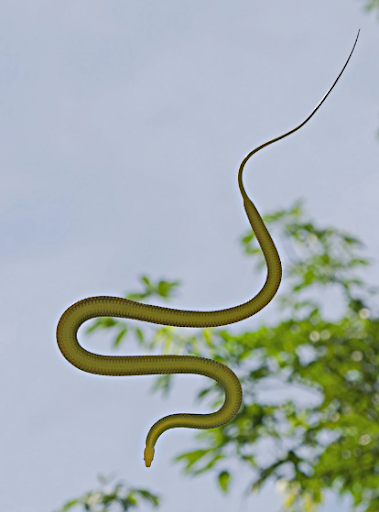
An action shot of a paradise tree snake in flight (Image from https://www.britannica.com/animal/flying-snake)
Flying snakes sound like something from a science fiction movie, but they do in fact exist, although technically they glide, not fly. When they glide, these snakes undulate from side to side, keeping the head stable. In most gliding animals, which are often mammals, paired ‘wings’ are used to generate lift, but obviously snakes have no such assistance for their glides. Take off is also particularly difficult for creatures without legs! The snakes prepare for take off by hanging from a branch with the body looped into a ‘J’ shape. The snake jumps up and away from the branch and as it falls, it moves its body into a ‘S’ shape. Close up studies of the snakes in motion revealed that they splay their ribs to the side, flattening their body and creating an unusual cross-sectional shape. This morphological change coupled with their undulations produces a very unusual glider with very different symmetries from all other fliers and gliders. This technique technically makes them better gliders than other famous gliders like squirrels and colugos (see Episode 278 for more information about the amazing flying lemurs, the colugos).
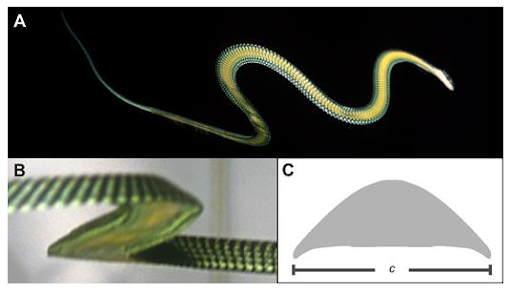
The body shape of the paradise tree snake in ‘flight’. A: a dynamic shot of the snake as it goes airborne. B: A close up of how the snake flattens its body to glide. C: the cross sectional geometry of the paradise tree snake as it glides. (Image from Holden et al, 2014)
Fortunately, the Paradise Tree Snakes and their close relatives are not facing any direct threats and are classed as Least Concern with a stable population by the IUCN red list. However, like so many species in Asia, there are threatened by the devastating levels of deforestation sweeping through that part of the world. The IUCN has determined that further studies are needed to determine the status of populations in heavily deforested areas.
Awesome videos
A clip from the National Geographic displaying the amazing gliding abilities of the paradise tree snake and how it uses its skills to grab a meal on the go.
A great clip showcasing the beauty of the Paradise Tree Snake.
References
Holden, D. Socha, J.J. Cardwell, N.D. and Vlachos, P.P. (2014) ‘Aerodynamics of the flying snake Chrysopelea paradisi: how a bluff body cross-sectional shape contributes to gliding performance.’ Journal of Experimental Biology.
https://www.britannica.com/animal/flying-snake
https://www.ecologyasia.com/verts/snakes/paradise_tree-snake.htm
https://www.iucnredlist.org/species/183189/1732041
Sarmiento, M.J.R. Petajen, J. Sarmiento, M.J.R. and Vargas, M. (2018) ‘Predation of a variable paradise tree snake by a Giant Golden Orb Weaver on Catanduanes Island, Philippines.’ Southeast Asia Vertebrate Records.
Socha, J.J. (2002) ‘Gliding flight in the paradise tree snake.’ Nature.
Socha, J.J. (2006) ‘Becoming airborne without legs: the kinematics of take-off in a flying snake, Chrysopelea paradisi.’ Journal of Experimental Biology.
Socha, J.J. O’Dempsey, T. and LaBarbera, M (2003) ‘A 3-D kinematic analysis of gliding in a flying snake.’ Journal of Experimental Biology.


